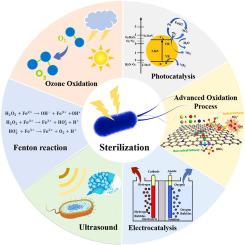Chemical Engineering Journal ( IF 13.3 ) Pub Date : 2020-12-25 , DOI: 10.1016/j.cej.2020.128207 Yi-di Chen , Xiaoguang Duan , Xu Zhou , Rupeng Wang , Shaobin Wang , Nan-qi Ren , Shih-Hsin Ho

|
The disinfection of microbial pathogens plays an important role in control of waterborne diseases and health issues. Recently, advanced oxidation processes (AOPs) are applied as powerful and effective technologies for wastewater purification and pathogen elimination. This review will showcase the recent endeavors in the fields and provide a comprehensive understanding of pathogens inactivation by diverse AOPs (i.e., Fenton processes, photocatalysis, electrochemical advanced oxidation processes (EAOPs), sonolysis, ozonation, and persulfate-based AOPs). The mechanisms of AOPs-based disinfection include the destruction of cell envelope, enzymes, and intracellular substances via diverse reactive oxygen species (ROS). The primary ROS are HO•, SO4•−, O2•−, 1O2, and O3, which exhibit different oxidative capacities, and can react with cell envelope to destroy the permeability of cell membrane. Specifically, this review emphasizes on the performances and mechanisms of different AOPs systems in microbial inactivation as well as perspectives in practical applications of disinfection in terms of feasibility, operating cost, and sustainability.
中文翻译:

用于水消毒的高级氧化工艺:特征,机理和前景
微生物病原体的消毒在控制水传播疾病和健康问题方面起着重要作用。最近,先进的氧化工艺(AOPs)被用作废水净化和病原体消除的强大而有效的技术。这篇综述将展示该领域的最新研究成果,并通过各种AOP(例如Fenton工艺,光催化,电化学高级氧化工艺(EAOP),声解,臭氧化和基于过硫酸盐的AOP)全面了解病原体的失活。基于AOP的消毒机制包括通过多种活性氧(ROS)破坏细胞膜,酶和细胞内物质。主要的ROS是HO •,SO 4 •-,O 2•−,1 O 2和O 3表现出不同的氧化能力,并且可以与细胞包膜反应破坏细胞膜的通透性。具体而言,本综述着重介绍了不同AOPs系统在微生物灭活中的性能和机理,以及从可行性,运营成本和可持续性方面对消毒实际应用的看法。





















































 京公网安备 11010802027423号
京公网安备 11010802027423号